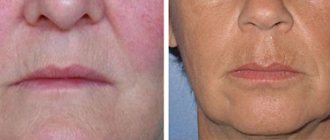general information
In laser eyelid blepharoplasty, a thin beam of high-energy light is directed onto the skin, leaving behind micro-incisions. Bleeding does not develop in this case, since due to the high temperature, small vessels are immediately cauterized, as if sealed. As a result, the risk of bacteria entering the wound and developing infection, as well as swelling and bruises, is minimized.
In addition, the width of the incisions themselves after the laser is much smaller than the width of the incisions after a scalpel, so the surrounding tissues are less injured, and the wound heals faster, leaving no scars.
Two types of lasers are used to perform laser blepharoplasty:
- CO2, or carbon dioxide. It has a more powerful beam of light, so it penetrates deeper into the skin. With its help, thin cuts are made, it also promotes coagulation of blood vessels, but due to the sudden heating of the tissues, it can leave behind a severe burn.
- Erbium. Its wavelength is almost three times shorter, so it penetrates shallowly into the skin. It cannot burn, but it is also less effective: it eliminates fine wrinkles through layer-by-layer evaporation of the skin.
The choice of laser is made by the doctor individually, depending on the severity of the changes.
During the laser blepharoplasty procedure, the cells are heated to a certain temperature, but are not destroyed. On the contrary, heat has a beneficial effect: muscle fibers, and with them the collagen framework, are strengthened, collagen synthesis is enhanced, the skin is tightened and rejuvenated.
Advantages of the method
How does laser non-surgical blepharoplasty differ from classical plastic surgery of the eyelids? There are practically no differences - the course of the procedure does not change, only the tool changes. Despite this, laser therapy has a wide range of advantages relative to traditional:
• using a laser can make thinner cuts than using a scalpel. The rate of restoration of damaged tissue increases several times, the risk of injury to other areas of the face is reduced, and the rehabilitation period is shortened;
• the use of a laser helps to immediately cauterize damaged vessels and stop the flow of blood. This reduces the degree of swelling and the number of hematomas;
• when using a laser there are no scars left;
• there is absolutely no risk of introducing infection into the body. Laser equipment immediately kills all pathogenic microbes.
Types of laser blepharoplasty
Depending on the location of the problem, the doctor may prescribe the following to the patient:
- Laser blepharoplasty of the upper eyelids. During the procedure, excess skin and fatty tissue are excised. As a result, the patient gets rid of drooping eyelids and a “heavy” look.
- Laser blepharoplasty of the lower eyelids. Required when the patient needs to remove fat bags, puffiness under the eyes, and sagging skin. It can be performed percutaneously (along the ciliary edge) or transconjunctivally (through the inner surface of the eyelid).
- Circular. Allows you to solve problems of two eyelids at once.
- Blepharoplasty for Asian eyes. A method of incision correction in which the “Mongolian” fold is removed and a Caucasoid fold is formed.
- Laser blepharoplasty with canthopexy. Prescribed for violation of the ligamentous apparatus in the eyelid area. During the operation, the shape and expression of the eyes are corrected.
The essence of the procedure
The main reason for the appearance of a “bag”, or more precisely, a hernia under the eyes, is a deficiency of collagen fibers in the thickness of the lower eyelid. This change in the 3D framework of the skin occurs with age in some people, and in others as a result of genetic predisposition.
A lack of collagen causes the lower eyelid to stretch. By sagging, the skin creates negative pressure, and it attracts fatty tissue, which is located around the eye and is designed to protect it from injury. Fat cells do not appear immediately under the lower eyelid. First, the vacuum should cause micro-holes to form in the membrane between the skin and the underlying tissue.
The laser used to perform non-surgical blepharoplasty is a special beam of light. Sent to the lower eyelid in microbeams, it evaporates columns of tissue in the skin. This activates fibroblast cells located along the perimeter of the evaporated microcolumns. Fibroblasts synthesize new collagen fibers, and the skin of the lower eyelid tightens. Along with infraorbital hernias, the wrinkles surrounding the eye also disappear: “crow’s feet”, nasolacrimal creases. Warming up the tissues that occurs during the procedure improves local blood circulation and lymphatic drainage, and the evaporation of fluid from the epidermal cells erases the pigmentation present there.
Indications and contraindications
With the help of laser blepharoplasty, patients get rid of age-related changes after 35–40 years and aesthetic imperfections. Meanwhile, there are medical indications for the procedure:
- excessive drooping of the lower or drooping upper eyelid (they impair vision);
- the presence of fatty hernias;
- drooping corners of the eyes, deformation of the eyelids and the appearance of a “heavy” look;
- facial asymmetry, different eye shapes, eye contour defects;
- the formation of deep wrinkles or crow's feet.
The procedure is also prescribed after injuries and burns.
Contraindications to laser eyelid blepharoplasty:
- individual sensitivity to laser;
- the presence of inflammation in the area of manipulation;
- oncology;
- HIV infection;
- blood clotting disorder;
- diabetes;
- somatic pathologies;
- epilepsy;
- fever;
- period of pregnancy and lactation;
- severe diseases of the cardiovascular system;
- some eye diseases and pathologies (dry eye syndrome, glaucoma, increased intraocular pressure, etc.)
- disruption of the endocrine system;
- infectious diseases.
The procedure may be delayed for other reasons that are determined individually.
What results can be achieved?
Non-surgical injection-based blepharoplasty is considered a quick and safe way to rejuvenate the skin on the face. The benefits of exposure include:
- minimal pain;
- safety;
- easy and minimal rehabilitation.
The result of the injections depends on the severity of age-related changes and the quality of the drug used. After injection blepharoplasty, subcutaneous fat in the eye area is removed, and epithelial regeneration processes begin.
This guarantees significant skin rejuvenation using a natural method. Thanks to lymphatic drainage, the epithelial and muscle layers of tissue regain elasticity. The results obtained after injection rejuvenation last for 1-4 years. After which the procedure is repeated.
We recommend: What is pinch blepharoplasty?
Preparing for surgery
Before performing circular blepharoplasty or blepharoplasty of the upper and lower eyelids with a laser, the doctor prescribes an examination. The patient is given directions to:
- blood test (general, biochemical, sugar);
- urine;
- coagulogram;
- electrocardiogram;
- fluorography.
The surgeon also evaluates the condition of the skin and muscle tissue around the eyes, determines the amount of excess, the tone of cartilage tissue, the depth of wrinkles and the degree of eyelid deformation. Along the way, he collects anamnesis regarding allergies to medications and, if necessary, prescribes consultations with specialists.
No special preparation is required from the patient, however, the doctor may recommend that the patient give up alcohol and smoking 7 to 10 days before and after laser blepharoplasty to speed up the healing process. They may also advise you to stop taking aspirin-based medications and hormonal medications.
The operation is usually performed on an empty stomach or no earlier than 5–6 hours after eating.
Anesthesia
The use of local anesthetics helps relieve pain during injection blepharoplasty.
In order to eliminate pain and spasms, it is necessary to apply an anesthetic in the form of a cream to the surface of the skin around the eyes.
The skin needs to be numbed
Important ! The choice of anesthetic drugs depends on the individual intolerance of the individual components and contraindications.
Progress of the operation
Most often, laser blepharoplasty is performed on an outpatient basis under local anesthesia. If additional procedures are planned, general anesthesia may be used.
First, the doctor makes markings and covers the pupil with a protective lens. The operated area is treated with a special cream with an antiseptic and after 10 - 15 minutes the surgeon makes incisions.
Upon completion of all manipulations, the wounds are sutured with absorbable sutures or their edges are “glued together” with surgical tape, and then they are treated with a product that reduces pain and minimizes the risk of swelling.
On average, the procedure lasts 15 – 20 minutes. Hospitalization is not necessary: the person can go home the same day.
Recovery
If you choose the right clinic and specialist for blepharoplasty, the rehabilitation period does not exceed 2 weeks. The patient is recommended to apply cold compresses in the first days to speed up recovery, and to avoid cosmetics for the next 10 days. It is better to sleep on your side or back, making sure that your head is slightly elevated.
In the first month, it is better to avoid serious physical and emotional stress. It is also not recommended to go to a bathhouse, sauna, be in the open sun (you should use sunglasses when going outside), or use aspirin-containing medications.
You can usually return to your normal lifestyle and go to work on the 10th day. At the same time, minor scars may still remain on the eyelids, which usually disappear after a few weeks.
Below are photos before and after laser blepharoplasty of the upper and lower eyelids:
Laser blepharoplasty before and after photos
Laser blepharoplasty of the lower eyelids video before, during and after:
Laser blepharoplasty review:
Laser blepharoplasty surgery (upper):
Forecast
After a properly performed procedure, excess skin and bags under the eyes, pigmentation are eliminated, the skin is evened out and rejuvenated. The effect lasts up to 10 years.
Possible side effects and complications:
- Dry eye syndrome or constant tearing. They are usually caused by dysfunction of the sebaceous glands and disappear within 2 to 3 weeks with the use of eye drops.
- Hematomas, swelling resulting from abnormally located vessels.
- Asymmetry of the eyelids. It happens not only when the specialist is insufficiently qualified, but also due to the individual structure of the skin.
- Burn, severe pain.
If any of these complications occur, you should immediately contact the doctor who performed the procedure. Don’t hesitate, your health is in your hands!
Consequences
Injection blepharoplasty rarely has negative side effects. Redness of the affected areas is considered a normal reaction of the body. In some cases, the following occurs:
- swelling;
- hematomas;
- pain at injection sites;
- tearfulness.
The phenomena go away on their own and do not require additional actions. If necessary, symptoms can be alleviated with cold compresses. In rare cases, inflammation of the injection sites occurs. This is a consequence of violation of sterility and non-compliance with hygiene rules.
Side effects include uneven distribution of dense gels and tissue necrosis due to improper administration of lipolytics. Phenomena occur due to inept actions of the doctor or incorrect choice of drug.









